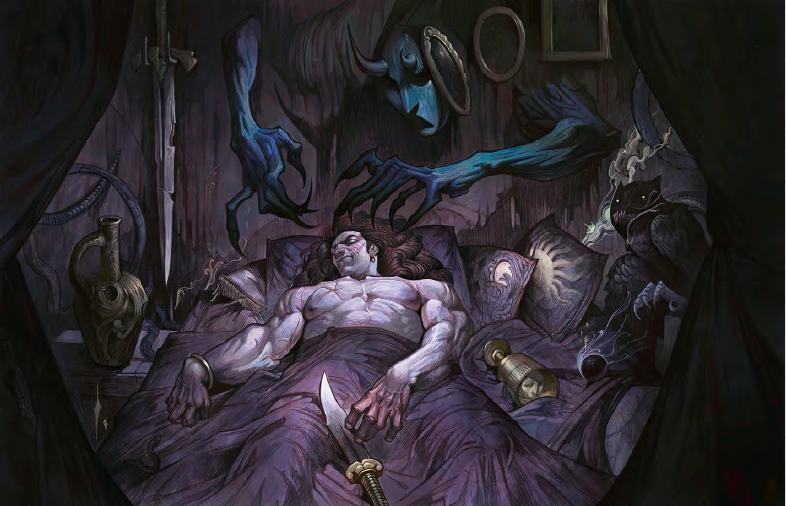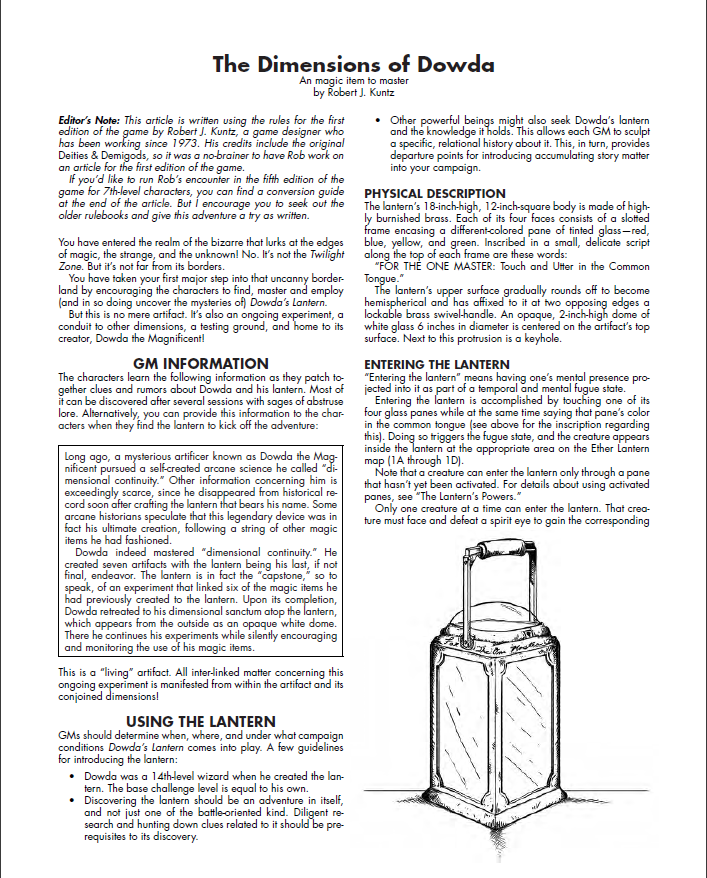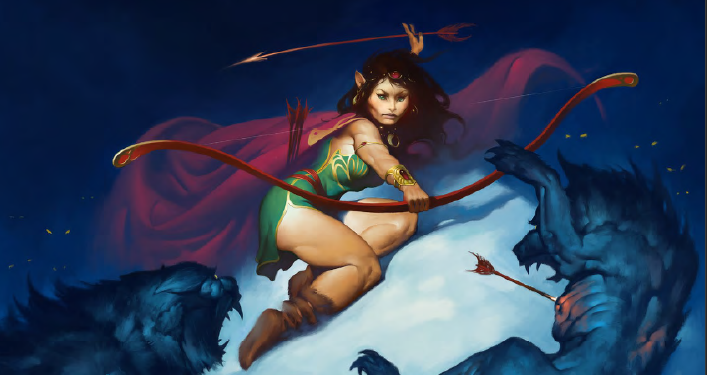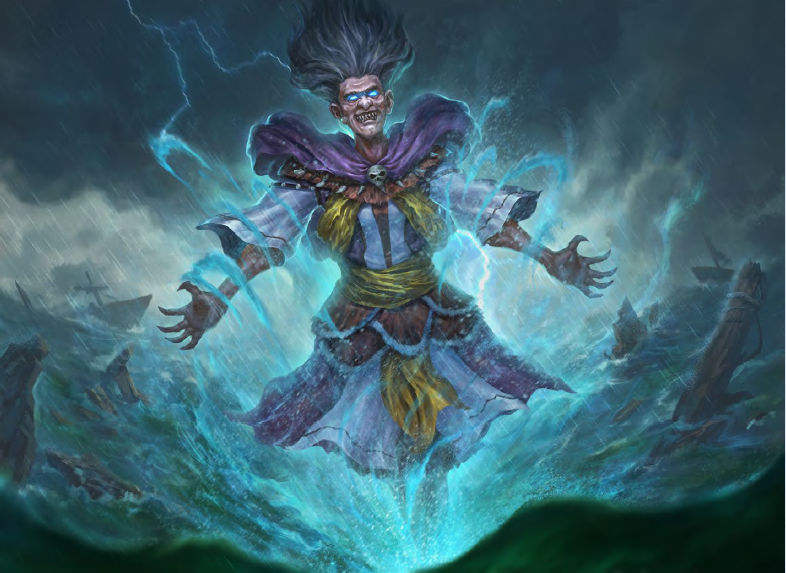All art belongs to MCDM
This month’s Arcadia is presented to us with a feline featured elven woman archer protecting herself from two attacking wolves in the tundra. While not as epic as other issues, it gives a bit of an old school style with the art design. It was made by the same artist who made the one from the Beastheart, and it is beautiful to look at. Just like its art design, this issue’s theme seems to focus on old-school D&D, or so says Matt in its letter. Nevertheless, I found it to be more monster oriented, as the first three articles didn’t scream in any way or form “old-school D&D to me”.
It seems that featuring a dungeon from an old-school TSR designer had Matt Colville himself want to write the “editor’s note”. Matt talks about how selections in design can give a feeling of old-school and how those feelings in a way had those worlds displayed in magazines feel real. It’s quite an interesting read, so I wouldn’t skip it if I were you.

The article starts with a content warning, which is something that is repeated in other sections of this same article. This is the only article in the issue that has them, so I guess that’s something that the author wrote and the editors decided to keep. It would be awesome if the team decided to add content warnings in the articles moving forward. It’s a nice little detail that might prevent some folk from reading things they wouldn’t want to. Just wanted to point that out.
The article is all about the transformation of harpies, driders, and medusas. How do they become what we define as “monsters”? Can this curse be broken? How? And what happens if a PC was to be cursed to become one of these creatures? It is a weird article in a way because I don’t think many people are actively thinking about removing the curse from these monstrous beings. Nevertheless, reading it works as an adventure spark. Now that I’ve read how removing a curse from a drider can be, creating a whole new narrative and encounters from it, I want to add that to a campaign!
The article offers a great deal of ideas on how to create a story about saving a person from a curse, the ramifications it may cause, and the different encounters you may find along the way. As I stated before, it is a great adventure spark that serves as inspiration for your game. I never thought of creating a tormented medusa the players can save, and now I want to throw one at them to see what happens. Additionally, the article comes with random tables for ways in which you can create a random exciting story and way to rid someone of a curse. Great stuff.

The next article is all about creatures from the Feywild and the Shadowfell. Being primarily a monster designer for the Vodari series, I was really interested in this section. Matt provides a very open space to experiment with Arcadia, meaning that it wouldn’t be weird to see creators experiment with their monsters.
Jonathan’s article is filled with monster templates that you can apply to NPCs (which I love having to experiment and apply to anything I want to throw in my story), as well as original monsters. The templates are primarily changes in the monster type and trading some spells for others, making them very simple. Experienced DMs may find some of it kind of obvious and things they can do on the fly, but it’s nice to see them stated out for the initiated, or in case it didn’t occur to you that you can do it. The monsters, on the other hand, there’s a lot to talk about, as I really liked what I saw:
The Monsters
The hags are *chef kiss*. Totally terrifying beings that became that way by adding very particular details. The red hag eats its enemies and flies at 150ft. Imagine seeing a red humanoid devouring something a long distance away, only to have it fly at almost the speed of Usain Bolt in your direction. The storm hag, as another example, is a gargantuan CR24 monster that can control storms. Fomorians are particularly interesting as well, but the new fey beings were the most interesting part to me.
The bogie, fachan and lubberkin are the new monsters, created just like all the other monsters in this article from mythological folklore from different sections of the world. I really liked he took the time to create all the monsters from actual folklore instead of just creating things that came out of his head. The three new creatures have their very own fascinating things, but it is the fachan I found I liked the most, and I didn’t even know the creature’s history. It can actually cause someone a heart attack, grapple it with its chain, and scare all the other PCs, while it escapes with the dying player character, jumping with its only foot.
Extra notes
The Feywild and fae creatures are things I always love to run in my D&D games, so it came as not surprise to me that I would really enjoy this article. Additionally, I wanted to stand out that the author knows that many of the fey beings come from fairy tails or myths in which feminism or the ugly are seen as evil things, and tells ways in which you can twist the story of these creatures to be villains in their own different but much more interesting ways. Lastly, I need to remark that all monsters have their own Tactics section, to make beginning DMs’ life easier when running this creatures, by featuring the best combos for each of them.

The Stuff of Nightmares is composed of two very detailed encounters, both involving nightmares. It begins with a short text that indicates how important dreams and nightmares can be in your D&D games, and why you should not use them to punish your players, but to move the story forward in an interesting direction.
The Glass Ghost
In this encounter, you visit a tavern located on Helm Street. I bet you can already tell where this is going. Without going too much into spoilery territory, this encounter is set to be a short one that will have many repercussions in the future. It’s pretty much Nightmare on Elm Street with some unique twists. It involves a monster created from one of the ancestries in
Arcadia 3 and the innkeeper searching for people to spend the night in her tavern.
The article thinks ahead the many different directions this encounter could go to. With each night that comes, the monster grows stronger, and not even defeating it can put an end to this curse. This encounter that involves several days rewards player creativity and planning. Nevertheless, the fact that this monster from your nightmare grows stronger day by day creates a fascinating ticking clock for the players. The monster has the villain actions that Matt talked about in one of its newest videos, as well as some terrifying abilities. I’ll definitely be running this encounter some day.
Hypnagougic Hauntings
At first glance, this encounter seems as if the author just wanted to create an extra simple encounter to add to the article. The text for the encounter is no more than a page long, and mostly describes what happens when you sleep. However, once you read the creatures’ stat blocks you understand where the effort was put into. Taking inspiration from creatures that feed from your dreams such as the Babadook, the hypnagoug becomes a terrifying monster you wish you never have to face.
The monster creates a whole interesting battle concept in its stat block. It goes for asleep creatures and feeds from its dreams, putting them in a state between being asleep and awake, which gives the PC a set of actions it can take in this state. You can’t just face the Hypnagoug. You need to summon it first, and to do that you need to let it feed from people’s dreams. That’s when the monster truly materializes, and “moisty” tendrils and tethers start appearing from everywhere. A true nightmare that came into being. The article says that you can have the monster attack the PCs, or have it already exist for some time in a town, meaning it has been feeding for some time.
The monster has villain actions as well to use once per round, as well as several means to escape. You will need a great plan to put an end to it. No map nor environment comes with this encounter. It is set to be easily placed anywhere you like.


This article is a very special one. It is created by TSR author and game designer from ye ol’ TSR Robert J. Kuntz. From what I’ve read, it doesn’t seem to be the only time we will be seeing him in Arcadia, as Robert talks in some places from the article about future things he will be writing for Arcadia. That’s interesting. Nevertheless, what is REALLY interesting is that this article is made for the first edition of D&D.
I’ve never been a fan of the layout from past editions. Even though I go read some old adventures from past editions to get some ideas for my games, its layout and design, especially for the first three editions, is something which I find uncomfortable. I am a guy who entered the RPG space during the 5e era, so that may be part of the problem. However, the way this item that is actually an adventure was designed is excellent. It feels just like reading those old adventures, thanks to its layout design and artstyle.
The item was created by a powerful wizard. It has an interdimensional space inside of it that kind of works like a dungeon. As the characters keep going through the dungeon, the one that is the “master” of the item keeps getting more powerful, until they fully unlock the item’s power. It has many combat encounters, weird interdimensional creatures, and it’s done so you can place the item anywhere you like, meaning it’s a portable dungeon for anytime in your campaign.
The adventure comes with its own old school map, as well as ways to port the adventure to 5e. You can appreciate the 1st edition-like layout in the image below:

Final thoughts
While the old school adventure isn’t something for me, it did give me some ideas that I might implement in future games. I can imagine people wanting to play a game of 1st ed D&D after seeing the article, and that’s an amazing thing. There’s something great in every edition and it would be cool to have an “extra article” containing stuff for previous editions of the game to have the reader want to try them out.
As for the original three articles from the issues, even though I don’t think I might not use much from the first article, I got lots of ideas I want to try out. The other two, on the other hand, are definitely things that makes this issue worth getting for me. The feywild and dreams are definitely my jam.
What’s your take on this issue? Does it have enough content to hook you? Is there any article that you think makes the whole issue worth getting? Or are you planning on using any of this articles in a way or form that is interesting enough to share? Make sure to tell me all about it in the comments below!
GET ARCADIA ISSUE FROM MCDM STORE
BECOME AN MCDM PATREON FOR FUTURE ARCADIA ISSUES














